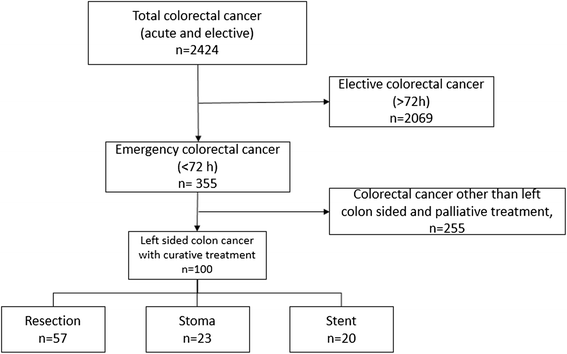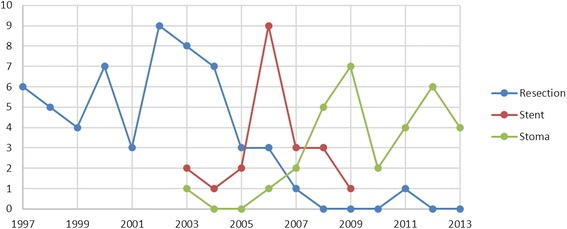Emergency management with resection versus proximal stoma or stent treatment and planned resection in malignant left-sided colon obstruction
- PMID: 27577887
- PMCID: PMC5006427
- DOI: 10.1186/s12957-016-0994-2
Emergency management with resection versus proximal stoma or stent treatment and planned resection in malignant left-sided colon obstruction
Abstract
Background: Emergency surgery for colon cancer, as a result of obstruction, has been vitiated by a high frequency of complications and poor survival. The concept of "bridge to surgery" includes either placement of self-expanding metallic stents (SEMS) or diverting stoma of an obstructing tumour and subsequent planned resection. The aim of this study was to compare acute resection with stoma or stent and later resection regarding surgical and oncological outcomes and total hospital stay.
Methods: This is a retrospective cohort study. All 2424 patients diagnosed with colorectal cancer during 1997-2013 were reviewed. All whom underwent acute surgery with curative intention for left-sided malignant obstruction were included in the study.
Results: One hundred patients fulfilled the inclusion criteria. Among them, 57 patients were treated with acute resection and 43 with planned resection after either acute diverting colostomy (n = 23) or stent placement (n = 20). The number of harvested lymph nodes in the resected specimen was higher in the planned resection group compared with acute resection group (21 vs. 8.7; p = 0.001). Fewer patients were treated with adjuvant chemotherapy in the acute resection group than in the stoma group (14 % (8/57 patients) vs. 43 %, (10/23 patients; p = 0.024)). Patients operated with acute resection had a higher 30-day mortality rate and were more frequently left with a permanent stoma.
Conclusions: Decompression of emergency obstructive left colon cancer with stent or stoma and subsequent curative resection appears safer and results in a higher yield of lymph node harvest, and fewer patients are left with a permanent stoma.
Keywords: Colon cancer; Emergency resection; Self-expanded metallic stent (SEMS); Stoma.
Figures
References
Publication types
MeSH terms
LinkOut - more resources
Full Text Sources
Other Literature Sources
Medical



